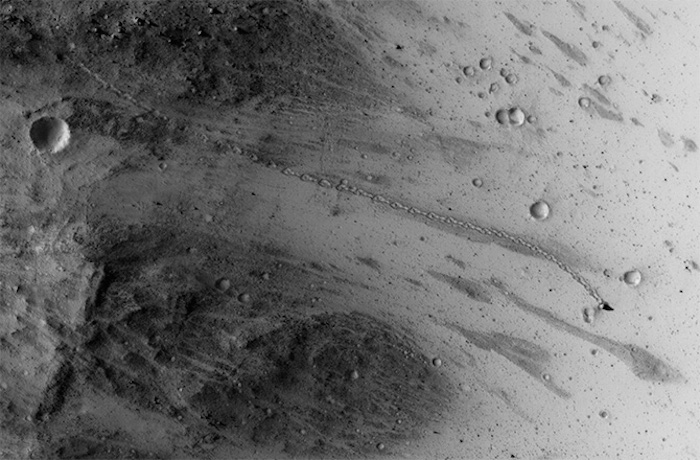.

HiRISE observation of the irregularly-shaped boulder and its track after coming to rest on its long axis at the bottom of a slope on Mars.
.
An orbiting Mars camera has spotted the aftermath of a fun event on Mars: A boulder that has rolled and bounced down a steep slope. But this isn’t any regular boulder, it’s a misshapen rock that has ended up resting on its long axis as a standing stone.

The photo above was snapped by the High-Resolution Imaging Science Experiment (HiRISE) camera on board NASA’s Mars Reconnaissance Orbiter (MRO) when the spacecraft was 170 miles above the Red Planet’s surface. The boulder apparently became dislodged in a “chaos” region near the Martian equator and bounced down the steep slope, leaving a regular pattern in the dusty landscape.
“The trail has a odd repeating pattern, as if the boulder couldn’t roll straight due to its shape,” said HiRISE principal investigator Alfred McEwen, of the University of Arizona.
And this is no small boulder. By looking at the length of the rock’s shadow CAST by the low sun, the HiRISE team estimate the rock is approximately 6 meters (20 ft) high by 3.5 meters (11.5 ft) wide. Therefore, if you stood next to the upright boulder, it would be like standing next to the tallest upright stone at Stonehenge, UK, which measures 6.7 meters (22 ft) high.
.

Close up of the HiRISE observation of the standing stone.
.
Mars rock slides and dusty “avalanches” are not rare events on Mars and the HiRISE camera is used to frequently SURVEY Mars cliffs and crate ridges for landslides, leading me to caution future Mars colonists that camping at the bottom of Mars hills is not such a great idea:
.

Trails of Mars rocks that have rolled down the slope of a crater rim as imaged by the HiRISE camera in an earlier observation... and a warning for Mars colonists.
Quelle: D-News
5222 Views
